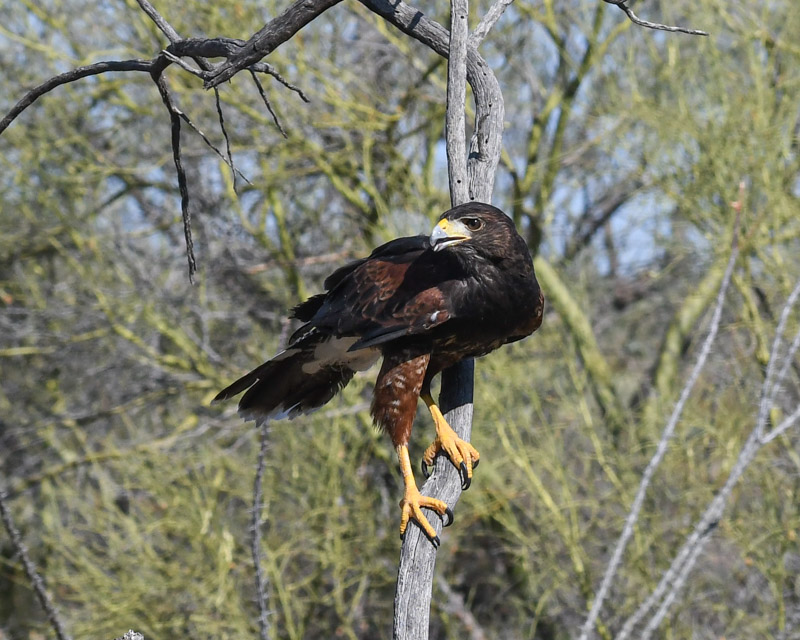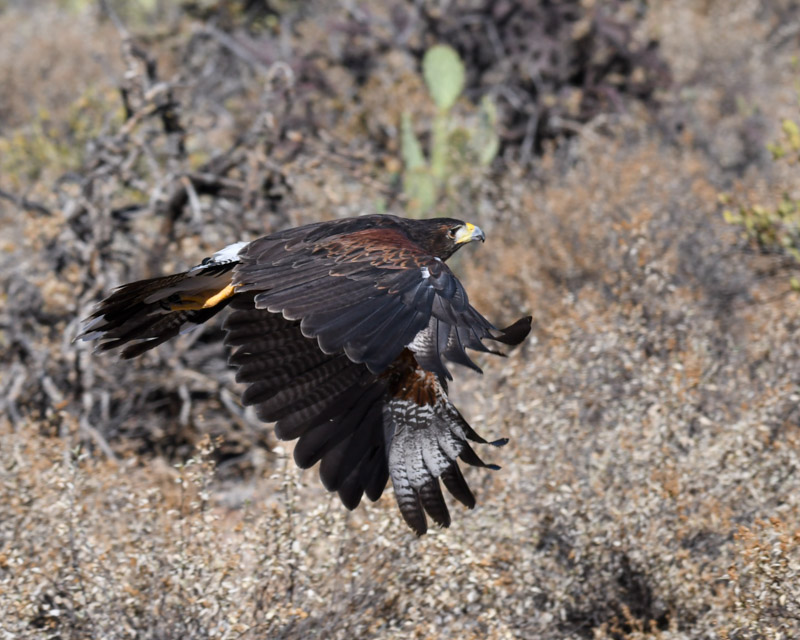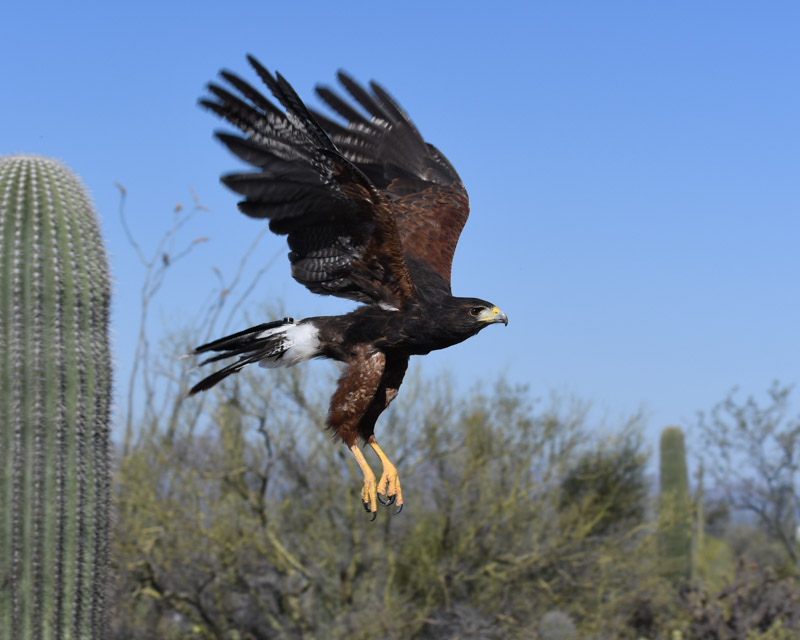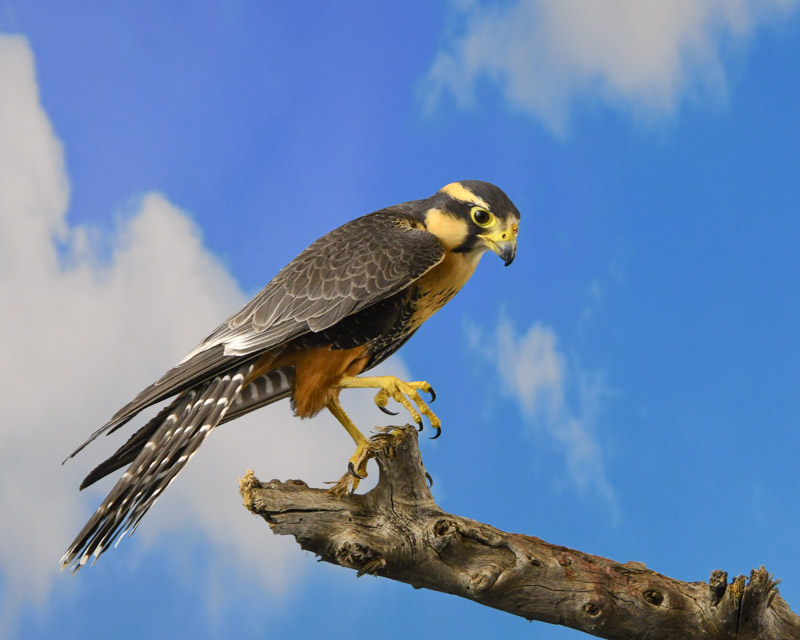By Dan Weisz
The extremely popular Raptor Free Flight Program at the Arizona Sonora Desert Museum created two summer classes in conjunction with the Museum’s Art Institute. Called a Hawk Walk, the participants were able to photograph a juvenile Harris’s Hawk in training flights in a desert area “behind the scenes” at the museum, and then came indoors for some studio portrait photography with several other raptors. The two classes sold out before any of the other summer Art Institute classes. One class has already been held and the other, with a waiting list, will be held this weekend. As a volunteer, I helped to provide support for the Hawk Walk during a morning training session just prior to the classes.
Harris’s Hawks are fairly new to the Sonoran Desert Region, with records going back about 150 years. They are a common bird of Mexico, Central and South America but they are sub-tropical birds needing permanent water. “Permanent” water came to the Sonoran Desert with the introduction of cattle ranches, stock tanks, and cattle ponds. We have Harris’s Hawks families at spots in the Foothills.

A juvenile Harris’s Hawk has barred wing feathers.

Harris’s Hawk are athletic flyers and can turn in space easily while chasing prey.

Here is another good look at the banded wing feathers and the speckled leggings of this juvenile as it takes off from a perch.

You can also see juvenile tail feathers. An adult will have that white rump patch and the white-tipped tail, but the tail feathers will be solid as opposed to this juvenile’s barred tail feathers.

The indoor session began with a rescued Peregrine Falcon. This bird is a few years old, having been “found” starving under a dumpster in a downtown Tucson alley in during a rainstorm. The bird had not fledged yet and could not fly or hunt for itself. After a stint in rehab, the bird came to the Desert Museum to be used as an education ambassador.
Peregrine Falcons are called the fastest animal on the planet, and they have been recorded as traveling over 240 mph during their famous stoops. If you can see that little ‘cone’ in their nostril, you can see a design that aids in their ability to travel so quickly. That cone, called a baffle, inspired a feature in modern jet engines that has allowed you to fly safely whenever you travel by plane. Here is an explanation of that feature in a favored photo blog that I follow: https://www.featheredphotography.com/blog/2016/01/10/juvenile-peregrine-falcon-plus-a-look-at-the-falcon-nostril-cone/
Peregrine Falcons do nest in canyons of the Catalinas and can be seen occasionally perched along telephone poles that line Skyline and Swan.

This bird would take his own flight path at times, ignoring the trainers’ requests.

Another of the rescued birds that Raptor Free Flight has is this Great Horned Owl. 13 years ago, her parents chose a top shelf of the nursery section of a Home Depot in Oro Valley as their nest site. That was fine until the eggs hatched and the owls began protecting their nest site by dive-bombing customers. AZ Game and Fish tried relocating the nest and the adult owls abandoned it. Shortly afterwards, “Snowshoe” came to the museum. In this photo, you can see the “brood patch” in her breast. That line down the middle of her breast shows where female birds lose feathers during breeding season. When they are sitting on eggs or on their young hatchlings, this allows for direct skin-to-egg or skin-to-baby contact to ensure greater heat transfer while caring for her young. Great Horned Owls are present in the Foothills.

The final bird of the Hawk Walk was this beautiful Aplomado Falcon. While once common in the dry grasslands of the southwest, these falcons are now endangered in the US and are being reintroduced in south Texas.

One of the 6 Falcon species in the United States, the Aplomado Falcon is bigger than an American Kestrel with a longer tail and longer wings, and smaller than a Prairie Falcon. Those long toes are used in capturing their prey.


It continues to be a privilege for me to be able to volunteer with the Raptor Free Flight Program at the Desert Museum.
